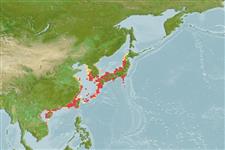>
Gobiiformes (Gobies) >
Oxudercidae (Mudskippers) > Periophthalminae
Etymology: Periophthalmus: Greek, peri = around + Greek, ophthalmos = eye (Ref. 45335).
Issue
Eschmeyer (CofF ver. Sep. 2011: Ref. 88002) recognizes Periophthalmus cantonensis (Osbeck, 1765) as valid on the basis of Cyprinus ccantonensis Osbeck, 1865 after several publications posterior to Murdy (1989: Ref. 5218) but without mentioning the later author that we follow here, The original description must be re-assessed as there is few chances that it is a Gobiidae. See Murdy (1989) for the history of that name.
Environment: milieu / climate zone / depth range / distribution range
Οικολογία
Θαλασσινό(ά); Γλυκού νερού; Υφάλμυρο βενθικό(ς); αμφίδρομο (Ref. 46888). Subtropical
Northwest Pacific: Vietnam (Ref. 44416), northward to Korea and southern Japan (Ref. 559).
Length at first maturity / Μέγεθος / Βάρος / Age
Maturity: Lm ?, range 4 - ? cm
Max length : 10.0 cm TL αρσενικό/απροσδιόριστο; (Ref. 5258)
Short description
Κλείδες προσδιορισμού | Μορφολογία | Μορφομετρία
Distinguished by the following characteristics: pelvic fins united anteriorly by a moderate
to strong frenum; medial rays united by a membrane for about half their length; D 1 height moderate, its margin rounded, a dusky stripe inframarginally and no spots on fin, no elongate spines; D2 with single dusky stripe inframarginally; dorsal fins not connected by membrane;
D I with 1O-l7 spines; longitudinal scale count 75-100; head width 14.1-19.8% SL; pelvic fin length 11.5-14.6% SL; length of anal fin base 16.1-22.2% SL; length of D2 base 19.8-24.1 % SL; total D2 elements 12-14; total anal fin elements 11-13; TRDB 19-29 (Ref. 5218).
Facultative air-breathing (Ref. 126274); Intertidal, actively shuttling back and forth between rock pools and air (Ref. 31184). They breathe air when out of water (Ref. 31184). Can stay out of the water for up to 22-60 hours if kept moist (Ref. 51276). Inhabits level mudflats with no vegetation (Ref. 92840). Found in estuaries, swamps, marshy areas and tidal mud flats. Moves around briskly on land preying on small animals. Used in Chinese medicine (Ref. 12166).
Life cycle and mating behavior
Γεννητική Ωρίμανση | Αναπαραγωγή | Γεννοβολία | Αβγά | Γονιμότητα | Προνύμφες
Murdy, E.O., 1989. A taxonomic revision and cladistic analysis of the oxudercine gobies (Gobiidae: Oxudercinae). Rec. Aust. Mus., Suppl. 11:1-93. (Ref. 5218)
IUCN Red List Status (Ref. 130435: Version 2024-1)
Threat to humans
Harmless
Human uses
αλιεία: χωρίς ενδιαφέρον; Ενυδρείο: Εμπορικό(ά)
Εργαλεία
Special reports
Download XML
Διαδικτυακές πηγές
Estimates based on models
Preferred temperature (Ref.
123201): 16.3 - 26.7, mean 22 °C (based on 280 cells).
Phylogenetic diversity index (Ref.
82804): PD
50 = 0.5000 [Uniqueness, from 0.5 = low to 2.0 = high].
Bayesian length-weight: a=0.00832 (0.00538 - 0.01287), b=2.98 (2.85 - 3.11), in cm total length, based on LWR estimates for this species & (Sub)family-body (Ref.
93245).
Τροφικό Επίπεδο (Ref.
69278): 3.2 ±0.4 se; based on size and trophs of closest relatives
Ελαστικότητα (Ref.
120179): Υψηλό, ελάχιστος χρόνος για διπλασιασμό πληθυσμού < 15 μήνες (Preliminary K or Fecundity.).
Fishing Vulnerability (Ref.
59153): Low vulnerability (10 of 100).
